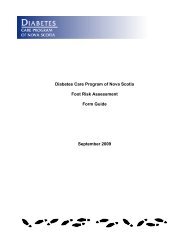CDE Appendix 1 Literature Review - Central East Local Health ...
CDE Appendix 1 Literature Review - Central East Local Health ...
CDE Appendix 1 Literature Review - Central East Local Health ...
You also want an ePaper? Increase the reach of your titles
YUMPU automatically turns print PDFs into web optimized ePapers that Google loves.
The Culture, Diversity and Equity Project: <strong>Literature</strong> <strong>Review</strong><br />
*"Information/Data Relevant to Cultural Competence" may include the following: ethnic/racial<br />
demographics, client language preference, epidemiological data related to various cultural groups served,<br />
community needs assessment, etc.<br />
DOMAIN: Communication<br />
Part I: Structure, Process and Output Indicators (Cont'd)<br />
The exchange of information between the organization/providers and the clients/population, and internally<br />
among staff, in ways that promote cultural competence.<br />
INDICATORS<br />
FOCUS AREAS STRUCTURE PROCESS OUTPUT<br />
Understanding<br />
of Different<br />
Communication<br />
Needs and<br />
Styles of Client<br />
Population<br />
• System for informing<br />
patients of right to free<br />
interpretation/translation<br />
services<br />
• System for identification and<br />
recording of population's<br />
and client's language<br />
preferences, level of<br />
proficiency, and literacy<br />
• System for access to trained<br />
interpreters<br />
• Curriculum and training<br />
programs for interpreters<br />
and staff<br />
• Fixed point of administrative<br />
responsibility for crosscultural<br />
communication<br />
support system<br />
Provides for staff<br />
training regarding<br />
cross-cultural<br />
communication<br />
" Monitors and<br />
evaluates cultural<br />
competence in<br />
organizational and<br />
provider<br />
communications<br />
• Special<br />
"communication"<br />
initiatives<br />
• Universal"<br />
language access<br />
• Linguistically<br />
competent services<br />
provided<br />
• Staff<br />
demonstrates/appli<br />
es effective<br />
communication<br />
styles with diverse<br />
groups<br />
Culturally<br />
Competent Oral<br />
Communication<br />
• Mechanisms for providing<br />
access to trained<br />
interpreters<br />
• Trained bi-lingual staff<br />
• Protocol(s) for when and<br />
how to elicit sensitive<br />
information from clients<br />
• Policy in place that<br />
minimizes the use of family<br />
members as interpreters<br />
• Provides for<br />
training and<br />
testing of<br />
interpreters<br />
and bi-lingual<br />
staff<br />
• Provides for<br />
staff training on<br />
use of<br />
interpreters<br />
• Languages/dialects<br />
of community<br />
available at point of<br />
first contact and all<br />
levels of interaction<br />
• Extent of use and<br />
timeliness of<br />
interpretation<br />
service, including<br />
requests and<br />
fulfillment of<br />
requests<br />
• Client<br />
understanding of<br />
interpreted material<br />
• Low interpretation<br />
errors<br />
112

















